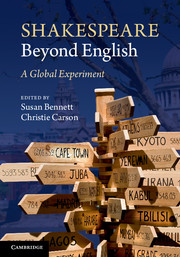Book contents
- Frontmatter
- Contents
- List of Illustrations
- List of colour plates
- Notes on contributors
- Foreword
- Acknowledgements
- Introduction
- The Globe to Globe Festival: An Introduction
- Performance Calendar
- Week One
- Week Two
- Week Three
- Week Four
- Week Five
- Week Six
- Chapter Thirty-Five Habima Merchant of Venice
- Chapter Thirty-Six Patriotism, Presentism and the Spanish Henry VIII
- Chapter Thirty-Seven Touch and Taboo in Roy-e-Sabs’ The Comedy of Errors
- Chapter Thirty-Eight Shakespeare and the Euro-crisis
- Chapter Thirty-Nine Restaging Reception
- Chapter Forty Reviving Hamlet? Nekrošius’ Lithuanian ‘Classic’
- Afterwords
- Index
- Plate section
- References
Chapter Thirty-Nine - Restaging Reception
Translating the mélange des genres in Beaucoup de bruit pour rien
Published online by Cambridge University Press: 05 June 2014
- Frontmatter
- Contents
- List of Illustrations
- List of colour plates
- Notes on contributors
- Foreword
- Acknowledgements
- Introduction
- The Globe to Globe Festival: An Introduction
- Performance Calendar
- Week One
- Week Two
- Week Three
- Week Four
- Week Five
- Week Six
- Chapter Thirty-Five Habima Merchant of Venice
- Chapter Thirty-Six Patriotism, Presentism and the Spanish Henry VIII
- Chapter Thirty-Seven Touch and Taboo in Roy-e-Sabs’ The Comedy of Errors
- Chapter Thirty-Eight Shakespeare and the Euro-crisis
- Chapter Thirty-Nine Restaging Reception
- Chapter Forty Reviving Hamlet? Nekrošius’ Lithuanian ‘Classic’
- Afterwords
- Index
- Plate section
- References
Summary
Compagnie Hypermobile debuted Beaucoup de bruit pour rien at the Cartoucherie, a factory-turned-theatre outside Paris. With each production, the Cartoucherie is completely transformed: directors alter seating and build new interior structures to suit their needs. For Beaucoup de bruit pour rien, Hypermobile turned the Cartoucherie into a stuffy, vaguely Edwardian Italian restaurant. But when director Clément Poirée brought the production to the Globe, he had to leave the set behind. The new setting became the Globe itself.
Publicity for Hypermobile's Globe performance continued to identify the setting as an Italian restaurant, causing some critical confusion. Hannah August claimed that ‘the production's design lacked coherence and the whole thing felt very much as though it had been transported from a proscenium arch theatre to the Globe stage’. Chris Michael writes, ‘It's apparently set in the only Italian restaurant on Earth that doesn't bother with such fripperies as food, tables or diners.’ Matt Wolf (understandably) did not even register a restaurant setting. He criticizes the ‘cumbersome stage business involving the Globe stage being swept clean [by Borachio]’; however, in the production's original setting this was not metatheatrical cliché but served to establish atmosphere and clarify Borachio's position in the labour hierarchy. By contrast, Paul Edmondson characterized the lack of set as exemplary of a ‘clarity’ and ‘straightforwardness’ that kept the emphasis on the storytelling. I agree that the lack of set did not spoil the performance, but I do not see the unadorned Globe stage as symbolically neutral. On the contrary, the moment the setting of the play shifted to the Globe, Poirée's stylistic choices became a commentary on the history of French Shakespeare. In what follows I analyse Hypermobile's Globe performance not only as a restaging of the Cartoucherie performance, but also as a restaging of Shakespeare's reception in France.
- Type
- Chapter
- Information
- Shakespeare beyond EnglishA Global Experiment, pp. 292 - 297Publisher: Cambridge University PressPrint publication year: 2013



